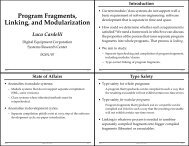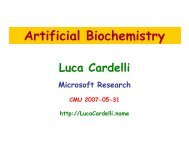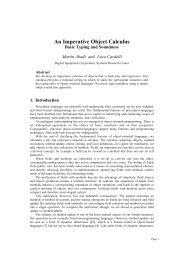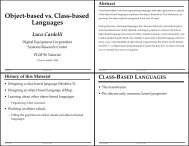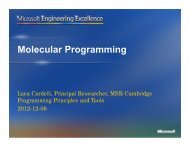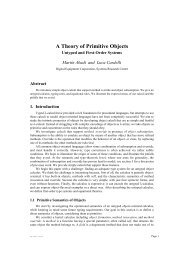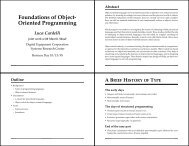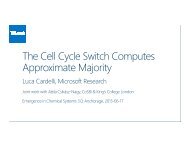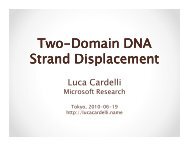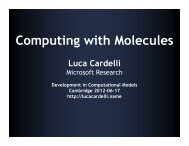Molecular Programming - Luca Cardelli
Molecular Programming - Luca Cardelli
Molecular Programming - Luca Cardelli
You also want an ePaper? Increase the reach of your titles
YUMPU automatically turns print PDFs into web optimized ePapers that Google loves.
<strong>Molecular</strong> <strong>Programming</strong><br />
<strong>Luca</strong> <strong>Cardelli</strong><br />
2013-06-21 TCN <strong>Programming</strong> Languages Community Event, Redmond
Objectives<br />
The promises of <strong>Molecular</strong> <strong>Programming</strong>:<br />
In Science & Medicine<br />
In Engineering<br />
In Computing<br />
The current practice of <strong>Molecular</strong> <strong>Programming</strong><br />
DNA technology<br />
<strong>Molecular</strong> languages and tools<br />
Example of a molecular algorithm
The Hardware Argument<br />
Smaller and smaller things can be built
Smaller and Smaller<br />
First working transistor<br />
John Bardeen and Walter Brattain , Dec. 23, 1947<br />
First integrated circuit<br />
Jack Kilby, Sep. 1958.<br />
50 years later<br />
25nm NAND flash<br />
Intel&Micron, Jan. 2010. ~50atoms<br />
Single molecule transistor<br />
Observation of molecular orbital gating<br />
Nature, 2009; 462 (7276): 1039<br />
Molecules on a chip<br />
~10 Moore’s Law cycles left!<br />
Placement and orientation of individual DNA shapes on lithographically<br />
patterned surfaces. Nature Nanotechnology 4, 557 - 561 (2009).
Building the Smallest Things<br />
How do we build structures that are by definition smaller than your tools?<br />
Basic answer: you can’t. Structures (and tools) should build themselves!<br />
By programmed self-assembly<br />
www.youtube.com/watch?v=Ey7Emmddf7Y
<strong>Molecular</strong> IKEA<br />
Nature can self-assemble.<br />
Can we?<br />
“Dear IKEA, please send me a chest<br />
of drawers that assembles itself.”<br />
We need a magical material where the pieces are<br />
pre-programmed to fit into to each other.<br />
Add water<br />
At the molecular scale many such materials exist…<br />
http://www.ikea.com/ms/en_US/customer_ser<br />
vice/assembly_instructions.html
Programmed Self-Assembly<br />
Proteins<br />
DNA/RNA<br />
Membranes<br />
Wikimedia
The Software Argument<br />
Smaller and smaller things can be programmed
We can program...<br />
Computers.<br />
Completely!<br />
Information<br />
Computing<br />
Information
We can program...<br />
Physical systems.<br />
Completely!<br />
(Modulo sensors/actuators)<br />
Sensing<br />
Computing<br />
Actuating
We can program...<br />
Matter<br />
Completely and directly!<br />
Sensing<br />
Computing<br />
Currently: only DNA/RNA.<br />
Constructing<br />
Actuating<br />
It's like a 3D printer without the printer!<br />
[Andrew Hellington]
What can we do with “just” DNA?<br />
Organize ANY matter [caveats apply]<br />
Execute ANY kinetics [caveats: up to time scaling]<br />
Build Nano-Control Devices<br />
Interface to Biology<br />
H.Lodish & al. <strong>Molecular</strong> Cell Biology 4 th ed.
Organizing Any Matter<br />
Use one kind of programmable<br />
matter (e.g. DNA).<br />
To organize (almost) ANY<br />
matter through it.<br />
6 nm grid of<br />
individually<br />
addressable<br />
DNA pixels<br />
+<br />
European Nanoelectronics Initiative Advisory Council<br />
"What we are really making are tiny DNA circuit boards<br />
that will be used to assemble other components."<br />
Greg Wallraff, IBM<br />
PWK Rothemund, Nature 440, 297 (2006)
Executing Any Kinetics<br />
The kinetics of any finite network of chemical reactions, can be<br />
implemented (physically) with especially programmed DNA<br />
molecules.<br />
Chemical reactions<br />
as an executable<br />
programming<br />
language for<br />
dynamical systems!<br />
2013-06-21 <strong>Luca</strong> <strong>Cardelli</strong> 14
Building Nano-Control Devices<br />
All the components of nanocontrollers can already be built entirerly and solely<br />
with DNA, and interfaced to the environment<br />
DNA Aptamers<br />
Sensing<br />
Computing<br />
DNA Logical Gates<br />
Constructing<br />
Self-assembling DNA Tiles<br />
Actuating<br />
DNA Walkers & Tweezers
Interfacing to Biology<br />
A doctor in each cell
The Biological Argument<br />
Biological systems are already<br />
‘molecularly programmed’
Abstract Machines of Biology<br />
Gene<br />
Machine<br />
Nucleotides<br />
Regulation<br />
H.Lodish & al. <strong>Molecular</strong> Cell Biology 4 th ed.<br />
Protein<br />
Machine<br />
Aminoacids<br />
Metabolism, Propulsion<br />
Signaling, Transport<br />
Hold receptors,<br />
host reactions<br />
Enact fusion, fission<br />
Glycan<br />
( Machine )<br />
Sugars<br />
Surface and<br />
Extracellular Features<br />
Membran<br />
Machine e<br />
Phospholipids<br />
Confinement, Storage<br />
Bulk Transport
Biological Languages<br />
Gene Networks<br />
<strong>Molecular</strong> Interaction<br />
Maps<br />
Gene<br />
Machine<br />
Nucleotides<br />
A<br />
x<br />
B<br />
Transport Networks<br />
y<br />
C<br />
P<br />
Q<br />
Protein<br />
Machine<br />
Aminoacids<br />
Membrane<br />
Machine<br />
Phospholipids
But ...<br />
Biology is programmable, but (mostly) not by us!<br />
Still work in progress:<br />
Gene networks are being programmed in synthetic biology, but using existing ‘parts’<br />
Protein networks are a good candidate, but we cannot yet effectively design proteins<br />
Transport networks are being looked at for programming microfluidic devices<br />
manipulating vesicles
<strong>Molecular</strong> Languages<br />
... that we can execute
Action Plan<br />
Building a full software/hardware pipeline for a new fundamental technology<br />
Mathematical Foundations<br />
<strong>Programming</strong> Languages<br />
Analytical Methods and Tools<br />
Device Architecture and Manufacturing<br />
[~ concurrency theory in the 80’s]<br />
[~ software engineering in the 70’s]<br />
[~ formal methods in the 90’s]<br />
[~ electronics in the 60’s]<br />
To realize the potential of <strong>Molecular</strong> <strong>Programming</strong><br />
“With no alien technology” [David Soloveichik]<br />
This is largely a ‘software problem’ even when working on device design
Our Assembly Language: Chemistry<br />
A Lingua Franca between Biology, Dynamical Systems,<br />
and Concurrent Languages<br />
Chemical Reaction Networks<br />
A + B r C + D (the program)<br />
Ordinary Differential Equations<br />
d[A]/dt = -r[A][B] … (the behavior)<br />
Rich analytical techniques based on Calculus<br />
But prone to combinatorial explosion<br />
E.g., due to the peculiarities of protein interactions
Chemistry as a Concurrent Language<br />
A connection with the theory of concurrency<br />
Via Process Algebra and Petri Nets<br />
Continuous-state Semantics<br />
(Mass Action Kinetics)<br />
ODE<br />
=<br />
ODE<br />
Combinatorial<br />
Explosion<br />
Continuous<br />
Chemistry<br />
Discrete<br />
Chemistry<br />
CTMC<br />
=<br />
Process<br />
Algebra<br />
CTMC<br />
Discrete-state Semantics<br />
(Chemical Master Equation)<br />
Nondeterministic<br />
Semantics<br />
Stochastic<br />
Semantics
How do we “run” Chemistry?<br />
Chemistry is not easily executable<br />
“Please Mr Chemist, execute me this bunch of reactions that I just made up”<br />
Most molecular languages are not executable<br />
They are descriptive (modeling) languages<br />
How can we execute molecular languages?<br />
With real molecules?<br />
That we can design ourselves?<br />
And that we can buy on the web?
<strong>Molecular</strong> <strong>Programming</strong><br />
with DNA<br />
Building the cores of programmable<br />
molecular controllers
The role of DNA Computing<br />
Non-goals<br />
Not to solve NP-complete problems with large vats of DNA<br />
Not to replace silicon<br />
Bootstrapping a carbon-based technology<br />
To precisely control the organization and dynamics of matter and information<br />
at the molecular level<br />
DNA is our engineering material<br />
Its biological origin is “accidental” (but convenient)<br />
It is an information-bearing programmable material<br />
Other such materials will be (are being) developed
Domains<br />
Subsequences on a DNA strand are called domains<br />
provided they are “independent” of each other<br />
CTTGAGAATCGGATATTTCGGATCGCGATTAAATCAAATG<br />
x<br />
y<br />
Differently named domains must not hybridize<br />
With each other, with each other’s complement, with subsequences of each<br />
other, with concatenations of other domains (or their complements), etc.<br />
z<br />
oriented DNA<br />
single strand
Short Domains<br />
t<br />
t<br />
t<br />
DNA double<br />
strand<br />
Reversible Hybridization
Long Domains<br />
x<br />
x<br />
x<br />
Irreversible Hybridization
Strand Displacement<br />
t<br />
t<br />
x<br />
x<br />
“Toehold Mediated”
Strand Displacement<br />
t<br />
x<br />
Toehold Binding
Strand Displacement<br />
t<br />
x<br />
Branch Migration
Strand Displacement<br />
t<br />
x<br />
Displacement
Strand Displacement<br />
x<br />
t<br />
x<br />
Irreversible release
Bad Match<br />
t<br />
t<br />
x<br />
x<br />
z<br />
y
Bad Match<br />
t<br />
x<br />
x<br />
z<br />
y
Bad Match<br />
t<br />
x<br />
x<br />
z<br />
y
Bad Match<br />
t<br />
x<br />
z<br />
y<br />
Cannot proceed<br />
Hence will undo
Two-Domain Architecture<br />
• Signals: 1 toehold + 1 recognition region<br />
t<br />
x<br />
• Gates: “top-nicked double strands” with open toeholds<br />
t x t y t<br />
Garbage collection<br />
“built into” the gate<br />
operation<br />
In S. B. Cooper, E. Kashefi, P. Panangaden (Eds.):<br />
Developments in Computational Models (DCM 2010).<br />
EPTCS 25, 2010, pp. 33-47. May 2010.
Plasmidic Gate Technology<br />
Synthetic DNA is<br />
length-limited<br />
Finite error probability at each<br />
nucleotide addition,<br />
hence ~ 200nt max<br />
Bacteria can replicate<br />
plasmids for us<br />
Loops of DNA 1000’s nt, with<br />
extremely high fidelity<br />
Practically no structural limitations<br />
on gate fan-in/fan-out<br />
Only possible with<br />
two-domain architecture
Transducer
Transducer x→y<br />
t<br />
Input<br />
x<br />
t<br />
a<br />
y<br />
t<br />
t x t a t a x t y t a t
Transducer x→y<br />
t<br />
Input<br />
x<br />
t<br />
a<br />
y<br />
t<br />
t x t a t a x t y t a t<br />
Built by self-assembly!<br />
ta is a private signal (a different ‘a’ for each xy pair)
Transducer x→y<br />
t<br />
a<br />
y<br />
t<br />
t x t a t a x t y t a t
Transducer x→y<br />
x<br />
t<br />
Active<br />
waste<br />
t<br />
a<br />
y<br />
t<br />
t x t a t a x t y t a t
Transducer x→y<br />
x<br />
t<br />
y<br />
t<br />
t x t a t a x t y t a t
Transducer x→y<br />
x<br />
t<br />
a<br />
t<br />
y<br />
t<br />
t x t a t a x t y t a t<br />
So far, a tx signal has produced an at cosignal.<br />
But we want signals as output, not cosignals.
Transducer x→y<br />
x<br />
t<br />
y<br />
t<br />
t x t a t a x t y t a t
Transducer x→y<br />
x<br />
t<br />
t<br />
a<br />
y<br />
t<br />
t x t a t a x t y<br />
a<br />
t
Transducer x→y<br />
x<br />
t<br />
t<br />
a<br />
t x t a t a x t y t<br />
a<br />
t
Transducer x→y<br />
x<br />
t<br />
Output<br />
t<br />
a<br />
t<br />
y<br />
t x t a t a x t y t<br />
a<br />
t<br />
Here is our output ty signal.<br />
But we are not done yet:<br />
1) We need to make the output irreversible.<br />
2) We need to remove the garbage.<br />
We can use (2) to achieve (1).
Transducer x→y<br />
x<br />
t<br />
Output<br />
t<br />
a<br />
t<br />
y<br />
t x t a t a x t y t<br />
a<br />
t
Transducer x→y<br />
t<br />
Output<br />
y<br />
t<br />
a<br />
t x t a t a x t y t<br />
a<br />
t
Transducer x→y<br />
x<br />
Output<br />
t<br />
a<br />
t<br />
y<br />
t x t a t a x t y t<br />
a<br />
t
Transducer x→y<br />
x<br />
t<br />
Output<br />
y<br />
t x t a t a x t y t a t
Transducer x→y<br />
a<br />
x<br />
t<br />
Output<br />
y<br />
t x t a t a x t y t a t
Transducer x→y<br />
a<br />
x<br />
t<br />
Output<br />
y<br />
t x t a t a x t y t a t<br />
Done.<br />
N.B. the gate is consumed: it is the energy source<br />
(no proteins, no enzymes, no heat-cycling, etc.; just DNA in salty water)
Transducer x→y
Join x+y→z
Tools and Techniques<br />
A software pipeline for <strong>Molecular</strong> <strong>Programming</strong>
High(er)-Level Languages<br />
Gene Networks<br />
<br />
<br />
Synchronous Boolean networks<br />
Stewart Kauffman, etc.<br />
Asynchronous Boolean networks<br />
René Thomas, etc.<br />
Protein Networks<br />
<br />
<br />
Process Algebra (stochastic π-calculus etc.)<br />
Priami, Regev-Shapiro, etc.<br />
Graph Rewriting (kappa, BioNetGen etc.)<br />
Danos-Laneve, Fontana & al., etc.<br />
Membrane Networks<br />
<br />
<br />
Membrane Computing<br />
Gheorghe Păun, etc.<br />
Brane Calculi<br />
<strong>Luca</strong> <strong>Cardelli</strong>, etc.<br />
Waiting for an architecture to run on...
<strong>Molecular</strong> Compilation<br />
Programs<br />
“High-Level”<br />
Language<br />
Boolean<br />
Networks<br />
Petri<br />
Nets<br />
Chemical Reaction<br />
Networks<br />
Gates<br />
Intermediate<br />
Language<br />
Strand<br />
DSD<br />
Algebra<br />
…<br />
Sequences<br />
Architecture<br />
4-domain<br />
Signals<br />
3-domain<br />
Signals<br />
2-domain<br />
Signals<br />
Devices<br />
Molecules
Development Tools<br />
MSRC Bio Computation Group<br />
Visual DSD<br />
A Development<br />
Environment<br />
for DNA Strand
A Language for DNA Structures<br />
Describe the initial<br />
structures
Compute Species and Reactions<br />
Recursively computed from<br />
the initial structures
Reaction Graph and Export
Simulation<br />
Stochastic<br />
Deterministic<br />
“JIT”
State Space Analysis
Modelchecking<br />
Export to PRISM probabilistic modelchecker
Verification<br />
Quantitative theories of system equivalence and<br />
approximation.
Related Work Supporter by our Tools<br />
Square root of a 4-bit number<br />
Associative memory
Execution<br />
A software/wetware pipeline for <strong>Molecular</strong><br />
<strong>Programming</strong>
Output of Design Process<br />
Domain structures<br />
(DNA sequences to be determined)<br />
“Ok, how do I<br />
run this for real”
From Structures to Sequences<br />
www.nupack.org<br />
DSD Structure<br />
“Dot-Paren” representation<br />
Output Sequences<br />
Thermodynamic<br />
Synthesis<br />
“Ok, where do I<br />
buy these?”
“DNA Synthesis”
From Sequences to Molecules<br />
Copy&Paste<br />
from nupack
Molecules by FedEx<br />
“Ok, how do I<br />
run these?”
Add Water
Execute (finally!)<br />
Fluorescence is your one-bit ‘print’ statement<br />
Windows XP!
Output
Debugging<br />
A core dump
Delivery!
A <strong>Molecular</strong> Algorithm<br />
Running something interesting with DNA
Approximate Majority Algorithm<br />
Given two populations of agents (or molecules)<br />
Randomly communicating by radio (or by collisions)<br />
Reach an agreement about which population is in majority<br />
By converting all the minority to the majority<br />
[Angluin et al., Distributed Computing, 2007]<br />
3 rules of agent (or molecule) interaction<br />
X + Y → B + B<br />
B + X → X + X<br />
B + Y → Y + Y<br />
“our program”
Surprisingly good (in fact, optimal)<br />
Fast: reaches agreement in O(log n) time w.h.p.<br />
O(n log n) communications/collisions<br />
Even when initially #X = #Y! (stochastic symmetry breaking)<br />
Robust: true majority wins w.h.p.<br />
If initial majority exceeds minority by ω(√n log n)<br />
Hence the agreement state is stable<br />
Stochastic simulation of worst-case<br />
scenario with initially #X = #Y
DNA Implementation, at U.W.<br />
Programmable chemical controllers made from DNA<br />
[Yuan<br />
Yuan-Jyue<br />
Chen, Neil Dalchau, Niranjan Srinivas, , Andrew Phillips, <strong>Luca</strong> <strong>Cardelli</strong>, David<br />
Soloveichik and Georg Seelig]
Final Remarks
A Brief History of DNA<br />
Turing Machine, 1936<br />
Structural DNA Nonotech, 1982<br />
Transistor, 1947<br />
DNA, -3,800,000,000<br />
DNA Algorithm, 1994<br />
Digital Computers<br />
Computer<br />
programming<br />
20 th century<br />
Software<br />
systematic<br />
manipulation<br />
of information<br />
<br />
systematic DNA Computers<br />
manipulation<br />
<strong>Molecular</strong><br />
of matter<br />
programming<br />
21 th century
Acknowledgments<br />
Microsoft Research<br />
Andrew Phillips, Biological Computation Group<br />
Caltech<br />
Winfree Lab<br />
U.Washington<br />
Seelig Lab
Questions?
Resources<br />
Visual DSD at MSR<br />
http://research.microsoft.com/en-us/projects/dna/<br />
<strong>Molecular</strong> <strong>Programming</strong> Project at Caltech<br />
http://molecular-programming.org/<br />
Georg Seelig’s DNA Nanotech Lab at U.W. CS&E<br />
http://homes.cs.washington.edu/~seelig/
©2013 Microsoft Corporation. All rights reserved.



